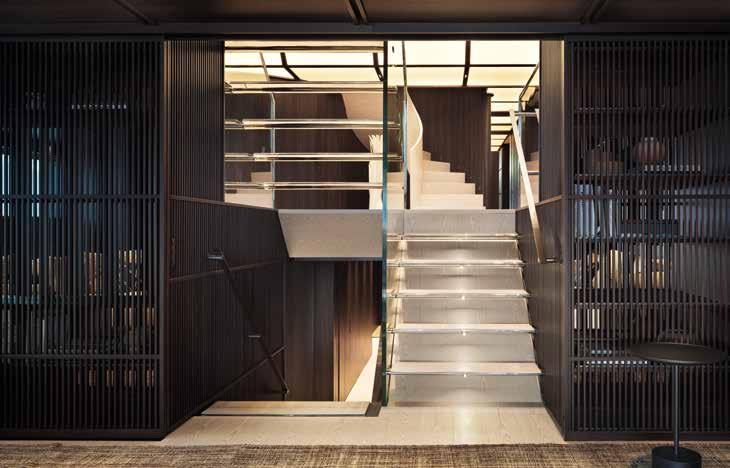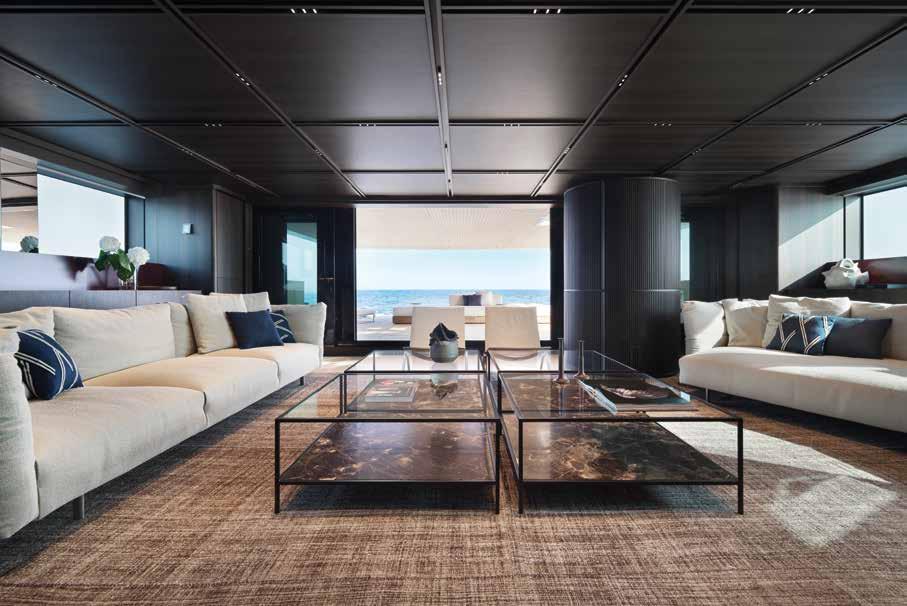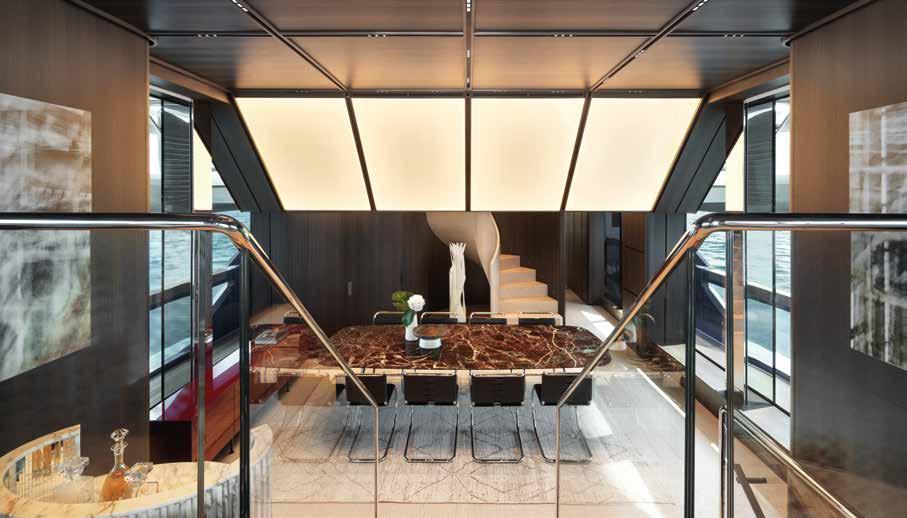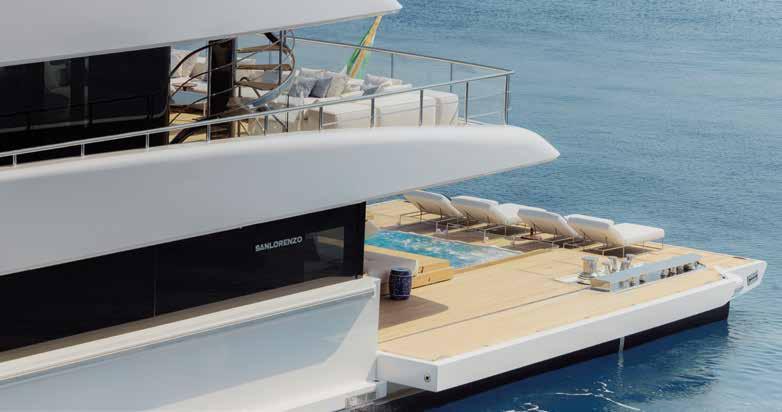





















There’s no doubt it’s the yacht of the year. It’s the first superyacht in the world to host the modular green methanol Reformer Fuel Cell system for generating electric power, and the first to feature the exclusive HER layout for the engine room – a new, disruptive interior architecture
by Désirée Sormani - ph. Guillaume Plisson

It was one of the dazzling stars of September’s boat show. A jewel of innovation, the 50Steel by Sanlorenzo, a yard that is always on the cutting edge of design and technical progress in the yacht-building world, is a new and important step towards carbon neutrality. Thanks to an exclusive agreement signed with Siemens Energy it is the first superyacht in the world to use a green methanol Reformer Fuel Cell electric current generation system. This solution enables the generation of up to 100 kW with engines and diesel generators off, providing hotel load without consuming diesel fuel, covering around 90% of typical superyacht use time with zero emissions. The result is an annual reduction in emissions of 20/30%. This gives Sanlorenzo a six-year lead over the rest of the yacht-building world in the context of the IMO strategies, which specify a 20% reduction in emissions from 2030. Produced using only renewable energy sources and carbon dioxide captured from the atmosphere, methanol is one the most efficient dieselreplacement fuels and is already available at over 100 ports around the world.
However, this is not the only innovation on board the 50Steel. An exclusive HER (Hidden Engine Room) system, involving modifications in the traditional yacht layout – the usual two levels hosting the propulsion units have been replaced by a horizontal development with a new configuration for the technical area in the under lower deck. This makes it possible to exploit new spaces in the lower deck area.
It’s a totally new development in terms of interior planning. The yacht is laid out over five staggered decks, generating spaces with expanded volumes that are open to the outside, reducing partitions and barriers. This new, disruptive interior architecture cannot be seen from the exterior – the yacht’s profile retains the clean, essential lines that are typical of Sanlorenzo models. The innovative design is the work of Zuccon International Project studio. Each of the 50Steel’s five decks stretches across two levels, developing the horizontal axis of the spaces with surprising plays of perspective and unexpected connections. The overall effect is that of a single huge space that maintains a constant dialogue with the exterior and the sea, thanks to extensive windows. The yacht’s spaces communicate with one another with only a few stairs, generating a natural feel to onboard movement, leaving guests constantly surprised by the new perspectives.
The dialogue among the spaces is created by the design by Piero Lissoni (art director of Sanlorenzo), who has given a contemporary interpretation to the stylistic cues of classic elegance – every detail of furniture, objects and soft décor is given great attention, from lamps to fabrics to the choice of 1960’s-style coloured tiles in the bathroom. For this complex, challenging project Piero Lissoni used integrated 3D models, making it possible for him to superimpose the technical model developed by Sanlorenzo over the architectural model, providing greater control over the details. www.sanlorenzoyacht.com


The stairs seamless connect the various spaces. The transformation of the traditional configuration has optimised every corner of the yacht. 50Steel hosts four guest cabins and the owner’s accommodation, for a total of 12 berths


A close connection with the sea becomes an integrating element in on-board life, starting with the Ocean Lounge aft. When its three terraces are open at anchor it becomes a 135 square metre beach connected to the guest cabins

50Steelistheworld’sfirstsuperyachttouseamethanolreformerfuelcellsystemforgeneratingelectricity.What hasthemarket’sreactionbeentothis? We’re proud to be able to say that the market has welcomed the 50Steel with great enthusiasm, recognising its revolutionary impact, especially in the context of sustainability: the combination of advanced technology and respect for the environment has attracted the attention of clients and aficionados, positioning 50Steel as a standard for the future of sustainable yacht-building

Howlongdidittaketodevelopthe50Steelandwhatdifficultiesdidyouencounter?The project demanded extensive initial development. This began in 2018 and culminated in 2021 through our collaboration with Siemens Energy. As it was a pioneering undertaking, we faced numerous engineering, technical, safety and design challenges: an ambitious project, but it resulted in a breakthrough that’s crucial for our future and the future of the entire industry. Howfarhastechicalinnovationinfluencedyourdesignsolutions? The Reformer Fuel Cell system has demanded a rethink of the spaces, and this involves the other great innovation on the 50Steel – the Hidden Engine Room system. Thanks to the horizontal development of the propulsion units and a new layout for the technical area, it frees up new living spaces on the lower deck.
50Steelisthefirstsuperyachttofeaturealayoutthatextendsoverfivesteppeddecks.Whattypeofownerareyou targeting? The innovation of offset decks enables us to reduce interior partitions and barriers, and it generates airy spaces that open out to the sea. This, together with an awareness of sustainability issues, responds to the requirements of a new generation of owners who seek to enjoy a more intense connection with nature and the sea, and wish to spend more time on board in environmentally-respectful conditions.
WhatarethenextchallengesforSanlorenzointermsofinnovation? In the line with the “Road to 2030” strategy, which involves delivery of the first carbon neutral yacht by 2030. Sanlorenzo is focussing on further development of fuel cell technology and the introduction of hybrid propulsion. By 2027 we aim to build a superyacht with a bi-fuel system 80% powered by green methanol, which will reduce emissions by a level much greater than the 55% set by the EU’s Fit for 55 agenda.